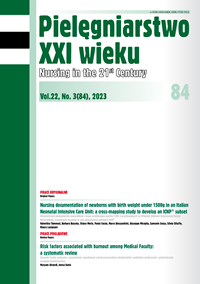Risk factors associated with burnout among Medical Faculty: a systematic review
DOI:
https://doi.org/10.2478/pielxxiw-2023-0030Keywords:
burnout, associated factors, prevalence, medical faculty, systematic reviewAbstract
RISK FACTORS ASSOCIATED WITH BURNOUT AMONG MEDICAL FACULTY: A SYSTEMATIC REVIEW
Aim. Burnout syndrome in academicians of healthcare professions adversely aff ects their well-being and performance during work, and it is considered common worldwide. The aim of this systematic review was to identify burnout factors among medical faculty.
Material and methods. Electronic searches were conducted in Citations and Abstracts for Literature of Nursing and Allied Health (CINAHL) Plus with full text, MEDLINE with full text, Academic Search Complete, and PsycInfo following the Preferred Reporting Items for Systematic Reviews and Meta-Analyses (PRISMA) guidelines. After excluding duplicates and articles, which did not meet the inclusion criteria, 17 studies were included in the final analysis. The Quality Index checklist developed by Downs & Black was used to evaluate the methodological quality of the included studies. There are no randomized controlled trials in our area of interest, and non-randomized studies scored low.
Results. A total of 17 studies (7,056 participants) across six countries were compatible with the inclusion criteria. Main associated factors of burnout included socio-demographic and work-related characteristics; physician factors (age, gender minority status, disability, desire to reduce the workload) and workplace culture; demographic factors, including sex, ethnicity/race, years of experience, specialty, and work-related factors; lack of institutional factors, such as mentorship, collaboration opportunities, feelings of empowerment, value, and support of well-being; poor faculty relationships and professional behaviors; perceived stressors, spousal/partner support, self-efficacy, and depression; long working hours, interpersonal interactions among the colleagues, family and social factors, including challenges related specifically to women, feelings and emotions, and personal qualities; high workload, limited time off, nature of work (high stake job), stigma/culture around burnout, administrative burden, lack of autonomy, and frequent performance feedback; high schedule misalignment; inadequate professional fulfillment, culture of wellness, personal reliance, and efficiency of practice; lack of organizational justice and job satisfaction; and anxiety-depression levels.
Conclusions. There was a considerable prevalence of burnout among medical faculty, which can be debilitating. Burnout among medical faculty remains the greatest threat to institutional growth and success.
References
1. Hashmi AM. The challenge of burnout in public medical teachers in Pakistan: A mixed methods study. Pakistan Journal of Medical Sciences. 2021;37(5):1268-1275. https://doi-org.ezproxy.ycp.edu:8443/10.12669/pjms.37.5.4429.
2. Gabbe SG, Hagan Vetter M, Nguyen MC, et al. Changes in the burnout profi le of chairs of academic departments of obstetrics and gynecology over the past 15 years. American Journal of Obstetrics & Gynecology. 2018,219(3):303.e1-303.e6. https://doi-org.ezproxy.ycp.edu:8443/10.1016/j.ajog.2018.06.012.
3. Grover S, Sahoo S, Bhalla A, et al. Psychological problems and burnout among medical professionals of a tertiary care hospital of North India: A cross-sectional study. Indian Journal of Psychiatry. 2018;60(2):175-188. https://doi-org.ezproxy.ycp.edu:8443/10.4103/psychiatry.IndianJPsychiatry_254_17.
4. Del Carmern, MG, Herman J, Rao S, et al. Trends and factors associated with physician burnout at a multispecialty academic faculty practice organization. JAMA Network Open. 2019; 2(3): e190554. https://doi-org.ezproxy.ycp.edu:8443/10.1001/jamanetworkopen.2019.0554
5. Duke, NN, Gross A, Moran A, et al. Institutional factors associated with burnout among assistant professors. Teaching & Learning in Medicine. 2020; 32(1): 61-70. https://doi.org/10.1080/10401334.2019.1638263
6. Burns KEA, Pattani R, Lorens E, et al. The impact of organizational culture on professional fulfi llment and burnout in an academic department of medicine. PloS One. 2021; 16(6): e0252778. https://doi-org.ezproxy.ycp.edu:8443/10.1371/journal.pone.0252778
7. Lee DH, Reasoner K, Lee D, et al. Is grit associated with burnout and well-being in orthopaedic resident and faculty physicians? A multi-institution longitudinal study across training levels. Clinical Orthopaedics and Related Research. 2021; 479(12): 2576-2586. https://doi-org.ezproxy.ycp.edu:8443/10.1097/CORR.0000000000001987
8. Ofei-Dodoo S, Callaway P, Engels K. Prevalence and etiology of burnout in a community-based graduate medical education system: A mixed-methods study. Family Medicine. 2019; 51(9): 766-771. https://doi-org.ezproxy.ycp.edu:8443/10.22454/FamMed.2019.431489
9. Purvis TE, Saylor D. Burnout and resilience among neurosciences critical care unit staff . Neurocritical Care. 2019; 31(2): 406-410. https://doi-org.ezproxy.ycp.edu:8443/10.1007/s12028-019-00822-4
10. Downs SH, Black N. The feasibility of creating a checklist for the assessment of the methodological quality both of randomised and non-randomised studies of health care interventions. Journal of Epidemiology & Community Health. 1998;52(6):377-384. http://refhub.elsevier.com/S1360-8592(16)30099-7/sref8
11. Adam S, Mohos A, Kalabay L, et al. Potential correlates of burnout among general practitioners and residents in Hungary: The signifi cant role of gender, age, dependent care and experience. BMC Family Practice. 2018; 19(1): 193. https://doi.org.ezproxy.ycp.edu:8443/10.1186/s12875-018-0886-3
12. Rotenstein L, Harry E, Wickner P, et al. Contributors to gender diff erences in burnout and professional fulfi llment: A survey of physician faculty. Joint Commission Journal on Quality & Patient Safety. 2021;47(11):723-730. https://doi-org.ezproxy.ycp.edu:8443/10.1016/j.jcjq.2021.08.002
13. Ko S, Guck A, Williamson M, et al. Family medicine faculty time allocation and burnout: A residency research network of Texas study. Journal of Graduate Medical Education. 2020; 12(5): 620-623. https://doi-org.ezproxy.ycp.edu:8443/10.4300/JGME-D-19-00930.1
14. Ofei-Dodoo S, Scripter C, Kellerman R, et al. Burnout and job satisfaction among family medicine residency coordinators: Results From a national survey. Family Medicine. 2018; 50(9): 679-684. https://doi-org.ezproxy.ycp.edu:8443/10.22454/FamMed.2018.921094
15. Dyrbye LN, Leep Hunderfund AN, Moeschler S, et al. Residents’ perceptions of faculty behaviors and resident burnout: A cross-sectional survey study across a large health care organization. Journal of General Internal Medicine. 2021;36(7):1906-1913. https://doi-org.ezproxy.ycp.edu:8443/10.1007/s11606-020-06452-3
16. Topbaş E, Bay H, Turan BB, el al. The eff ect of perceived organisational justice on job satisfaction and burnout levels of haemodialysis nurses. Journal of Renal Care. 2019; 45(2): 120-128. https://doi-org.ezproxy.ycp.edu:8443/10.1111/jorc.12271
17. Yilmaz A. Burnout, job satisfaction, and anxiety-depression among family physicians: A cross-sectional study. Journal of Family Medicine & Primary Care. 2018;5:952-956. https://doi-org.ezproxy.ycp.edu:8443/10.4103/jfmpc.jfmpc_59_18
18. Ironside K, Becker D, Chen I, et al. Resident and faculty perspectives on prevention of resident burnout: A focus group study. The Permanente Journal. 2019;23(3):18-185. https://doi.org/10.7812/TPP/18-185.
Downloads
Published
Issue
Section
License
Copyright (c) 2023 Authors

This work is licensed under a Creative Commons Attribution 4.0 International License.




